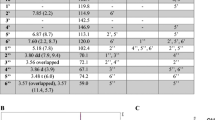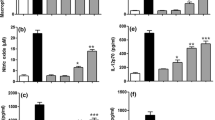Abstract
Schinus terebinthifolia leaf lectin (SteLL) was reported to be an antimicrobial and antitumor agent. In this work, we evaluated the immunomodulatory activity of SteLL on mice splenocytes and also determined its native molecular mass and putative sequence similarities with plant proteins. The effects of SteLL (12.5 μg/mL) on viability, cytosolic Ca2+ concentration ([Ca2+]cyt), cytosolic and mitochondrial levels of reactive oxygen species (ROS), and mitochondrial transmembrane potential (ΔΨm) of mice splenocytes were determined. In addition, the culture supernatants were collected for quantification of interleukins (IL), tumor necrosis factor (TNF), interferon-gamma (IFN-γ) and nitric oxide (NO). SteLL showed a native molecular mass of 12.4 kDa and tandem mass spectrometry (MS/MS) ions search revealed similarities with adenosine triphosphate (ATP) synthase and F1-ATPase from plants (4% and 6% coverage, respectively). SteLL was not toxic to splenocytes, did not alter the [Ca2+]cyt and ROS levels, and slightly reduced ΔΨm. The presence of SteLL stimulated the cells to release pro-inflammatory cytokines (IL-17A, TNF-α, IFN-γ and IL-2) and also of IL-4, an anti-inflammatory cytokine that can prevent exacerbated inflammation. SteLL induced decrease in the secretion of NO. In conclusion, SteLL has biotechnological potential as an immunomodulator agent for use in studies employing cultures of immune cells. In addition, the anti-infectious and antitumor properties of the leaves may involve the immunomodulation property of SteLL.




Similar content being viewed by others
Abbreviations
- ΔΨm:
-
Mitochondrial transmembrane potential
- [Ca2+]cyt :
-
Cytosolic Ca2+ concentration
- AnnV:
-
Annexin V
- ATP:
-
Adenosine triphosphate
- CBA:
-
Cytometric bead array
- CXCL:
-
Chemokine (C-X-C motif) ligand
- ESI-QUAD-TOF:
-
Electrospray ionization quadrupole time-of-flight
- FITC:
-
Fluorescein isothiocyanate
- HA:
-
Hemagglutinating activity
- HSP70:
-
70-kDa heat shock proteins
- IC50 :
-
Concentrations that reduced cell viability to 50%)
- IFN-γ:
-
Interferon-gamma
- IL:
-
Interleukin
- JAK/STAT:
-
Janus kinases/signal transducer and activator of transcription proteins
- MIP-1α:
-
Macrophage inflammatory protein 1α
- MS/MS:
-
Tandem mass spectrometry
- NO:
-
Nitric oxide (NO)
- PBS:
-
Phosphate buffered saline
- PI:
-
Propidium iodide
- ROS:
-
Reactive oxygen species
- SDS-PAGE:
-
Polyacrylamide gel electrophoresis in the presence of sodium dodecyl sulphate
- SteLL:
-
Schinus terebinthifolia leaf lectin
- Th:
-
T helper
- TNF:
-
Tumor necrosis factor
- UFPE:
-
Universidade Federal de Pernambuco
References
Blume B, Nürnberger T, Nass N, Scheel D (2000) Receptor-mediated increase in cytoplasmic free calcium required for activation of pathogen defense in parsley. Plant Cell 12:1425–1440
Brito JS, Ferreira GRS, Klimczak E, Gryshuk L, Santos NDL, Patriota LLS, Moreira LR, Soares AKA, Barboza BR, Paiva PMG, Navarro DMAF, Lorena VMB, Melo CML, Coriolano MC, Napoleão TH (2017) Lectin from inflorescences of ornamental crop Alpinia purpurata acts on immune cells to promote Th1 and Th17 responses, nitric oxide release, and lymphocyte activation. Biomed Pharmacother 94:865–872
Brune M, Castaigne S, Catalano J, Gehlsen K, Ho AD, Hofmann WK, Hogge DE, Nilssom B, Or R, Romero AI, Simonsson B, Spearing R, Stadtmauer EA, Szer J, Wallhult E, Hellstrand K (2006) Improved leukemia-free survival after postconsolidation immunotherapy with histamine dihydrochloride and interleukin-2 in acute myeloid leukemia: results of a randomized phase 3 trial. Blood 108:88–96
Coelho LCBB, Silva PMS, Lima VLM, Pontual EV, Paiva PMG, Napoleão TH, Correia MTS (2017) Lectins, interconnecting proteins with biotechnological/pharmacological and therapeutic applications. Evid Based Complement Altern Med 2017:1594074
Degasperi GR, Zecchin KG, Borecky J, Cruz-Höfling MA, Castilho RF, Velloso LA, Guimarães F, Vercesi AE (2006) Verapamil-sensitive Ca2+ channel regulation of Th1-type proliferation of splenic lymphocytes induced by Walker 256 tumor development in rats. Eur J Pharmacol 54:179–184
Ding AH, Nathan CF, Stuehr DJ (1988) Release of reactive nitrogen intermediates and reactive oxygen intermediates from mouse peritoneal macrophages. Comparison of activating cytokines and evidence for independent production. J Immunol 141:2407–2412
Dwyer JM, Johnson C (1981) The use of concanavalin A to study the immunoregulation of human T cells. Clin Exp Immunol 46:237–249
Ermak G, Davies KJ (2002) Calcium and oxidative stress: from cell signaling to cell death. Mol Immunol 38:713–721
Gomes FS, Procópio TF, Napoleão TH, Coelho LCBB, Paiva PMG (2013) Antimicrobial lectin from Schinus terebinthifolius leaf. J Appl Microbiol 114:672–679
Haney EF, Hancock REW (2013) Peptide design for antimicrobial and immunomodulatory applications. Biopolymers 100:572–583
Hiroi M, Sakaeda Y, Yamaguchi H, Ohmori Y (2013) Anti-inflammatory cytokine interleukin-4 inhibits inducible nitric oxide synthase gene expression in the mouse macrophage cell line RAW264.7 through the repression of octamer-dependent transcription. Mediat Inflamm 2013:369693
Laemmli UK (1970) Cleavage of structural proteins during the assembly of the head of bacteriophage T4. Nature 227:680–685
Lannoo N, Van Damme EJM (2010) Nucleocytoplasmic plant lectins. Biochim Biophys Acta Gen Subj 1800:190–201
Lindenmaier DS, Putzke J (2011) Estudo etnobotânico em três comunidades Mbya/Guarani na região central do Rio Grande do Sul, Brasil. Cad Pesq 23:6–18
Lowry OH, Rosebrough NJ, Farr AL, Randall RJ (1951) Protein measurement with the folin-phenol reagent. J Biol Chem 193:265–275
Melo CML, Paim BA, Zecchin KG, Morari J, Chiaratti MR, Correia MTS, Coelho LCBB, Paiva PMG (2010) Cramoll 1,4 lectin increases ROS production, calcium levels, and cytokine expression in treated spleen cells of rats. Mol Cell Biochem 342:163–169
Mitra S, Leonard WJ (2018) Biology of IL-2 and its therapeutic modulation: mechanisms and strategies. J Leukoc Biol 103:643–655
Mittal M, Siddiqui MR, Tran K, Reddy SP, Malik AB (2014) Reactive oxygen species in inflammation and tissue injury. Antiox Redox Signal 20:1126–1167
Morton JF (1978) Brazilian pepper—its impact on people, animals and the environment. Econ Bot 32:353–359
Murphy MP, Siegel RM (2013) Mitochondrial ROS fire up T cell activation. Immunity 38:201–202
Patriota LLS, Procópio TF, Brito JS, Sebag V, Oliveira APS, Soares AKA, Moreira LR, Lima TA, Soares T, Silva TD, Paiva PMG, Lorena VMB, Melo CML, Albuquerque LP, Napoleão TH (2017) Microgramma vacciniifolia (Polypodiaceae) fronds contain a multifunctional lectin with immunomodulatory properties on human cells. Int J Biol Macromol 103:36–46
Patriota LLS, Brito JS, Barboza BR, Paiva PMG, Melo CML, Napoleão TH (2019) A review on the immunomodulatory effects of plant lectins. In: Ng TB, Wong J, Tse R, Tse TF, Chan H (eds) Hemagglutinins: structures, functions and mechanisms. Nova Science Publishers, New York, pp 53–82
Procópio TF, Moura MC, Albuquerque LP, Gomes FS, Santos NDL, Coelho LCBB, Pontual EV, Paiva PMG, Napoleão TH (2017) Antibacterial lectins: action mechanism, defensive roles and biotechnological potential. In: Collins E. (org) (ed) Antibacterials: synthesis, properties and biological activities. Nova Science Publishers, New York, pp 69–89
Procópio TF, Patriota LLS, Barros BRS, Aguiar LMS, Lorena VMB, Paiva PMG, Melo CML, Napoleão TH (2018) Calliandra surinamensis lectin (CasuL) does not impair the functionality of mice splenocytes, promoting cell signaling and cytokine production. Biomed Pharmacother 107:650–655
Ramos DBM, Araújo MTMF, Araújo TCL, Santos-Neto OG, Silva MG, Silva YA, Torres DJL, Patriota LLS, Melo CML, Lorena VMB, Paiva PMG, Mendes RL, Napoleão TH (2019) Evaluation of antitumor activity and toxicity of Schinus terebinthifolia leaf extract and lectin (SteLL) in sarcoma 180-bearing mice. J Ethnopharmacol 233:148–157
Ribas MO, Sou HM, Sartoretto J, Lanzoni TA, Noronha L, Acra LA (2006) Efeito da Schinus terebinthifolius Raddi sobre o processo de reparo tecidual das lesões ulceradas induzidas na mucosa bucal do rato. Rev Odonto Ciênc 21:245–252
Rosenberg SA (2014) IL-2: the first effective immunotherapy for human cancer. J Immunol 192:5451–5458
Santos TAR, Silva AC, Silva EB, Gomes PATM, Espíndola JWP, Cardoso MVO, Pereira VR (2016) Antitumor and immunomodulatory activities of thiosemicarbazones and 1,3-thiazoles in Jurkat and HT-29 cells. Biomed Pharmacother 82:555–560
Shrihari TG (2017) Dual role of inflammatory mediators in cancer. Ecancermedicalscience 11:721
Strbo N, Yin N, Stojadinovic O (2014) Innate and adaptive immune responses in wound epithelialization. Adv Wound Care 3:492–501
Tsien RY (1988) Fluorescence measurement and photochemical manipulation of cytosolic free calcium. Trends Neurosci 11:419–424
Acknowledgements
The authors express their gratitude to the Conselho Nacional de Desenvolvimento Científico e Tecnológico (CNPq; 408789/2016-6) for research grants and fellowships (RBZ, PMGP and THN) as well as to the Coordenação de Aperfeiçoamento de Pessoal de Nível Superior (CAPES, Finance Code 001) and Fundação de Amparo à Ciência e Tecnologia do Estado de Pernambuco (FACEPE; APQ-0108-2.08/14; APQ-0661-2.08/15) for financial support. The authors thank the Núcleo de Plataformas Tecnológicas of the Instituto Aggeu Magalhães, Fundação Oswaldo Cruz (FIOCRUZ Pernambuco). We thank Ana Lucia Oliveira Carvalho and Augusto Vieira for technical assistance with mass spectrometry analysis.
Author information
Authors and Affiliations
Corresponding author
Ethics declarations
Conflict of interest
The authors declare that they have no conflict of interest in the publication.
Rights and permissions
About this article
Cite this article
dos Santos, A.J.C.A., da Silva Barros, B.R., de Souza Aguiar, L.M. et al. Schinus terebinthifolia leaf lectin (SteLL) is an immunomodulatory agent by altering cytokine release by mice splenocytes. 3 Biotech 10, 144 (2020). https://doi.org/10.1007/s13205-020-2137-2
Received:
Accepted:
Published:
DOI: https://doi.org/10.1007/s13205-020-2137-2




